This is an order of battle for the Battle of the Coral Sea.
| Carrier Striking Force – Vice Admiral Takeo Takagi, Commander; Carrier Division 5 - Rear Admiral Chūichi Hara, Officer in Tactical Command | ||||||||||
|---|---|---|---|---|---|---|---|---|---|---|
| Ship | Type | Commander | Casualties | Notes | ||||||
| Killed | Wounded | Total | ||||||||
 Shōkaku |
Fleet carrier | Rear Admiral Takatsugu Jojima | 108 | 40 | 148 | Badly damaged. | ||||
 Zuikaku |
Fleet carrier | Captain Ichibei Yokokawa | 0 | 0 | 0 | Bomber group commander- Kakuichi Takahashi, Torpedo group commander- Shigekazu Shimazaki (Millot, p. 154) | ||||
 Haguro |
Heavy cruiser | Captain Tomokazu Mori | 0 | 0 | 0 | |||||
 Myōkō |
Heavy cruiser | Captain Teruhiko Miyoshi | 0 | 0 | 0 | |||||
 Ushio |
Destroyer | Lieutenant Commander Yoshitake Uesugi | 0 | 0 | 0 | |||||
 Akebono |
Destroyer | Lieutenant Commander Minoru Nakagawa | 0 | 0 | 0 | |||||
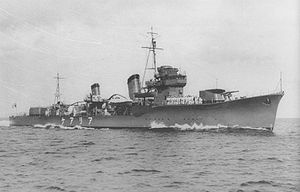 Ariake |
Destroyer | Lieutenant Commander Shooichi Yoshida | 0 | 0 | 0 | |||||
 Yugure |
Destroyer | Lieutenant Commander Kiyoshi Kamo | 0 | 0 | 0 | |||||
 Shiratsuyu |
Destroyer | Lieutenant Commander Kanematsu Hashimoto | 0 | 0 | 0 | |||||
 Shigure |
Destroyer | Lieutenant Commander Noboru Seo | 0 | 0 | 0 | |||||
| Tōhō Maru | Oiler | Unknown (check combinedfleet) | 0 | 0 | 0 | |||||
 Aichi D3A Type 99 "kanbaku" |
Dive bomber | 0 | 0 | 0 | 21 each on Shōkaku and Zuikaku for a total of 42. | |||||
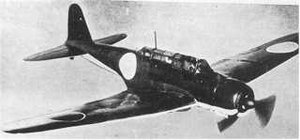 Nakajima B5N Type 97 "kankō" |
Torpedo bomber | 19 on Shōkaku and 21 on Zuikaku. | ||||||||
 A6M2 Zero |
Fighter | 18 on Shōkaku and 20 on Zuikaku. | ||||||||
| Total casualties: 15 killed, 72 wounded, 87 total | ||||||||||
| Tulagi Invasion Group – Rear Admiral Kiyohide Shima, commander | ||||||||||
 Okinoshima |
Minelayer | ? | 0 | 0 | 0 | Shima's flagship. Lightly damaged. Sunk by US submarine S-42 on 10 May during Operation RY | ||||
 Kikuzuki |
Destroyer | ? | ? | ? | ? | Sunk | ||||
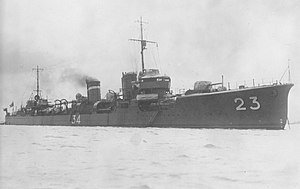 Yūzuki |
Destroyer | Lieutenant Commander Hirota Tachibana | 10 | 20 | 30 | Strafed by Yorktown fighters on May 4. Moderately damaged and Tachibana killed. | ||||
| Koei Maru | Minelayer | |||||||||
| Wa #1 | Minesweeper | Sunk | ||||||||
| Wa #2 | Minesweeper | Sunk | ||||||||
| Hagoromo Maru | Minesweeper | |||||||||
| Noshiro Maru #2 | Minesweeper | |||||||||
| Tama Maru | Minesweeper | Sunk | ||||||||
| Toshi Maru #3 | Submarine chaser | |||||||||
| Tama Maru #8 | Submarine chaser | |||||||||
| Azumasan Maru | Troopship | |||||||||
| Total casualties: | ||||||||||
| Port Moresby Invasion Group - Rear Admiral Sadamichi Kajioka, commander | ||||||||||
 Yūbari |
Light cruiser | Captain Masami Ban | 0 | 0 | 0 | Kajioka's flagship | ||||
 Asanagi |
Destroyer | ? | ? | ? | ? | |||||
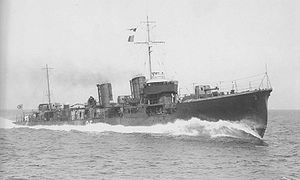 Uzuki |
Destroyer | |||||||||
 Mutsuki |
Destroyer | |||||||||
 Mochizuki |
Destroyer | |||||||||
 Yayoi |
Destroyer | |||||||||
 Oite |
Destroyer | |||||||||
| One or two smaller warships | Patrol boat | |||||||||
| Total casualties: | ||||||||||
| Port Moresby Transport Unit - Rear Admiral Kōsō Abe, commander | ||||||||||
 Tsugaru |
Minelayer | Abe's flagship | ||||||||
| Ojima | Auxiliary repair ship | ? | ? | ? | ? | |||||
| Goyo Maru | Fleet oiler | |||||||||
| Hoyo Maru | Fleet oiler | |||||||||
| Iro | Fleet oiler | |||||||||
| W-20 | Minesweeper | |||||||||
| Hagoromo Maru | Minesweeper | |||||||||
| Noshiro Maru #2 | Minesweeper | |||||||||
| Fumi Maru #2 | Minesweeper | |||||||||
| 11–12 transports | Troopship | |||||||||
| Total casualties: | ||||||||||
| Support Group/Close Cover Force - Rear Admiral Kuninori Marumo, commander | ||||||||||
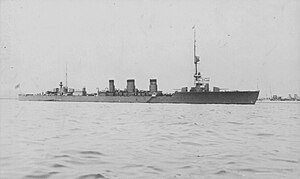 Tenryū |
Light cruiser | Marumo's flagship | ||||||||
 Tatsuta |
Light cruiser | ? | ? | ? | ? | |||||
| Kamikawa Maru | Seaplane tender | |||||||||
| Keijo Maru | Gunboat | |||||||||
| Seikai Maru | Gunboat | |||||||||
| Nikkai Maru | Gunboat | |||||||||
| Hagoromo Maru | Minesweeper | |||||||||
| Noshiro Maru #2 | Minesweeper | |||||||||
| Fumi Maru #2 | Minesweeper | |||||||||
| 11–12 transports | Troopship | |||||||||
| Total casualties: | ||||||||||
other units
- Support Group/Close Cover Force - Rear Admiral Kuninori Marumo
- Covering Group - Rear Admiral Aritomo Gotō
- Submarine Force - Captain Noburu Ishizaki
Air units:
- 25th Air Flotilla-
Sadayoshi Yamada
- Rabaul- 44 Zero, 41 G3M, 13 H6K. (Yokohama Air Group)
- Lae- 16 Zero
- Buna- 7 G3M
- Shortland- 3 H6K, 4 light seplanes
- Tulagi- 6 A6M.2N Zero (float Zeros?)
- Deboyne- 12 seaplanes (Millot, 152-153 for this info)
Lundstrom (2006), p. 547 (footnote #14 from p. 137) states that the Base Air Force on 1 May had 23 Zeros, 42 bombers, and 13 Kawanishi flying boats.
Task Force 17 - Vice Admiral Frank Jack Fletcher
- Task Group 17.2 (Attack Group) - Rear Admiral
Thomas C. Kinkaid
- cruisers Minneapolis, New Orleans, Astoria, Chester, Portland
- destroyers Phelps, Dewey, Farragut, Aylwin, Monaghan
- Task Group 17.3 (Support Group) - Rear Admiral John Gregory Crace
- Task Group 17.5 (Carrier Group) - Rear Admiral Aubrey Fitch, Officer in Tactical Command (OTC)
- Task Group 17.6 (Fueling Group) - Captain
John S. Phillips
- oilers Neosho (sunk), Tippecanoe [1]
- destroyers Sims (sunk), Worden
- Task Group 17.9 (Search Group) - Commander George H. DeBaun
- Reserve (at Noumea)
- Destroyers DD388 Helm and DD391 Henley (ONI, p. 53; Millot, p. 157)
- Lexington's 2nd Air Group was commanded by Commander W. B. Ault; VF2 by LTCr Ramsey, VB2 by LTCr W.L. Hamilton, VS2 by LTCr R. E. Dixon, and VT2 by LTCr Brett (Millot, p. 158)
- Yorktown's 5th Air Group was commanded by LTCr Pederson, VF42 by LTCr Fenton, VB5 by Lt Short, VS5 by LTCr Burch, VT5 by LTCr J. Taylor (Millot, pp. 158-159)
- Four US submarines from Task Force 42, based in Australia under Rear Admiral Francis W. Rockwell, deployed around the Rabaul area. Lundstrom (2006), p. 133.
- MacArthur's land based air forces, under Lieutenant General George Brett. Eighteen B-17, 16 B-26, 14 B-25, 10 RAAF Hudsons, 3 RAAF PBY. Lundstrom (2006), p. 133–134, 160.
Wikimedia Commons has media related to
Battle of the Coral Sea.
Sources:
- Millot, pp. 150–154 (Japanese), pp. 155–159 (Allied)
Dull, pp. 135-137Lundstrom (2006), pp. 138-140 (Japanese)Bullard, pp. 47–48, 53–54, 61 (Japanese land-based air forces, 25th Air Flotilla), 51–52, 56-57, 59 (ships assigned), apparently the IJA commander of the South Seas force was on Matsue Maru (64)- D'Albas, pp. 109–110 (both)- not really useful
- Hata, pp. 42-44, Shokaku air group org info.
- Henry, pp. 22-24.
- Morison, pp. 17-20.
Crave, pp. 411-414, 424–425 (US Army AF and RAAF in Australia and New Guinea) 447–448 (Genzan Air Group and Allied land-based squadrons involved)Gill, p. 40 (Japanese), 42 (Allied submarines)Gillison, p. 519 (RAAF and US land-based aircraft), p. 520 for total number of sorties by MacArthur's aircraft, 525-526 for Japanese order of battle.ONI, pp. 10-11 (US/Aus and cc), pp. 30-40 for notes on casualties of US escort ships and claims.USACMH, Vol II Japanese OOB, including number of planes with Kamikawa Maru at Deboyne.USSBS, p. 54.Furutaka TROMYubari TROMTenryu TROMGoyo Maru TROMOkinoshima TROMUzuki TROMOjima TROMWillmott, Barrier and Javelin, pp. 84-87. Includes Japanese transport ship names.Willmott, Barrier, pp. 190-192, 195-197. US OOB including land-based bomber numbers.
- ^ The two oilers carried a total of 153,000 barrels. TF11 and TF17 together burned about 11,400 barrels a day at normal cruising speed. (Lundstrom (2006), p. 135).
- ^ Cressman, p. 84; Millot, p. 53, 157. Millot states that Tangier was forced to remain at Noumea because, since it was a naval asset under Nimitz and Fletcher, it was not allowed to operate in MacArthur's area. Thus, the ship's catalinas were too far away to patrol the area of the Coral Sea where the battle took place. The two PBY squadrons on Tangier were VP71 and VP73. One squadron of six arrived on 3 May. The planes had a 700 mile search radius, allowing them to reach just short of San Cristobal and Rennell Island (Lundstrom (2006), p. 134).
This is an order of battle for the Battle of the Coral Sea.
| Carrier Striking Force – Vice Admiral Takeo Takagi, Commander; Carrier Division 5 - Rear Admiral Chūichi Hara, Officer in Tactical Command | ||||||||||
|---|---|---|---|---|---|---|---|---|---|---|
| Ship | Type | Commander | Casualties | Notes | ||||||
| Killed | Wounded | Total | ||||||||
 Shōkaku |
Fleet carrier | Rear Admiral Takatsugu Jojima | 108 | 40 | 148 | Badly damaged. | ||||
 Zuikaku |
Fleet carrier | Captain Ichibei Yokokawa | 0 | 0 | 0 | Bomber group commander- Kakuichi Takahashi, Torpedo group commander- Shigekazu Shimazaki (Millot, p. 154) | ||||
 Haguro |
Heavy cruiser | Captain Tomokazu Mori | 0 | 0 | 0 | |||||
 Myōkō |
Heavy cruiser | Captain Teruhiko Miyoshi | 0 | 0 | 0 | |||||
 Ushio |
Destroyer | Lieutenant Commander Yoshitake Uesugi | 0 | 0 | 0 | |||||
 Akebono |
Destroyer | Lieutenant Commander Minoru Nakagawa | 0 | 0 | 0 | |||||
 Ariake |
Destroyer | Lieutenant Commander Shooichi Yoshida | 0 | 0 | 0 | |||||
 Yugure |
Destroyer | Lieutenant Commander Kiyoshi Kamo | 0 | 0 | 0 | |||||
 Shiratsuyu |
Destroyer | Lieutenant Commander Kanematsu Hashimoto | 0 | 0 | 0 | |||||
 Shigure |
Destroyer | Lieutenant Commander Noboru Seo | 0 | 0 | 0 | |||||
| Tōhō Maru | Oiler | Unknown (check combinedfleet) | 0 | 0 | 0 | |||||
 Aichi D3A Type 99 "kanbaku" |
Dive bomber | 0 | 0 | 0 | 21 each on Shōkaku and Zuikaku for a total of 42. | |||||
 Nakajima B5N Type 97 "kankō" |
Torpedo bomber | 19 on Shōkaku and 21 on Zuikaku. | ||||||||
 A6M2 Zero |
Fighter | 18 on Shōkaku and 20 on Zuikaku. | ||||||||
| Total casualties: 15 killed, 72 wounded, 87 total | ||||||||||
| Tulagi Invasion Group – Rear Admiral Kiyohide Shima, commander | ||||||||||
 Okinoshima |
Minelayer | ? | 0 | 0 | 0 | Shima's flagship. Lightly damaged. Sunk by US submarine S-42 on 10 May during Operation RY | ||||
 Kikuzuki |
Destroyer | ? | ? | ? | ? | Sunk | ||||
 Yūzuki |
Destroyer | Lieutenant Commander Hirota Tachibana | 10 | 20 | 30 | Strafed by Yorktown fighters on May 4. Moderately damaged and Tachibana killed. | ||||
| Koei Maru | Minelayer | |||||||||
| Wa #1 | Minesweeper | Sunk | ||||||||
| Wa #2 | Minesweeper | Sunk | ||||||||
| Hagoromo Maru | Minesweeper | |||||||||
| Noshiro Maru #2 | Minesweeper | |||||||||
| Tama Maru | Minesweeper | Sunk | ||||||||
| Toshi Maru #3 | Submarine chaser | |||||||||
| Tama Maru #8 | Submarine chaser | |||||||||
| Azumasan Maru | Troopship | |||||||||
| Total casualties: | ||||||||||
| Port Moresby Invasion Group - Rear Admiral Sadamichi Kajioka, commander | ||||||||||
 Yūbari |
Light cruiser | Captain Masami Ban | 0 | 0 | 0 | Kajioka's flagship | ||||
 Asanagi |
Destroyer | ? | ? | ? | ? | |||||
 Uzuki |
Destroyer | |||||||||
 Mutsuki |
Destroyer | |||||||||
 Mochizuki |
Destroyer | |||||||||
 Yayoi |
Destroyer | |||||||||
 Oite |
Destroyer | |||||||||
| One or two smaller warships | Patrol boat | |||||||||
| Total casualties: | ||||||||||
| Port Moresby Transport Unit - Rear Admiral Kōsō Abe, commander | ||||||||||
 Tsugaru |
Minelayer | Abe's flagship | ||||||||
| Ojima | Auxiliary repair ship | ? | ? | ? | ? | |||||
| Goyo Maru | Fleet oiler | |||||||||
| Hoyo Maru | Fleet oiler | |||||||||
| Iro | Fleet oiler | |||||||||
| W-20 | Minesweeper | |||||||||
| Hagoromo Maru | Minesweeper | |||||||||
| Noshiro Maru #2 | Minesweeper | |||||||||
| Fumi Maru #2 | Minesweeper | |||||||||
| 11–12 transports | Troopship | |||||||||
| Total casualties: | ||||||||||
| Support Group/Close Cover Force - Rear Admiral Kuninori Marumo, commander | ||||||||||
 Tenryū |
Light cruiser | Marumo's flagship | ||||||||
 Tatsuta |
Light cruiser | ? | ? | ? | ? | |||||
| Kamikawa Maru | Seaplane tender | |||||||||
| Keijo Maru | Gunboat | |||||||||
| Seikai Maru | Gunboat | |||||||||
| Nikkai Maru | Gunboat | |||||||||
| Hagoromo Maru | Minesweeper | |||||||||
| Noshiro Maru #2 | Minesweeper | |||||||||
| Fumi Maru #2 | Minesweeper | |||||||||
| 11–12 transports | Troopship | |||||||||
| Total casualties: | ||||||||||
other units
- Support Group/Close Cover Force - Rear Admiral Kuninori Marumo
- Covering Group - Rear Admiral Aritomo Gotō
- Submarine Force - Captain Noburu Ishizaki
Air units:
- 25th Air Flotilla-
Sadayoshi Yamada
- Rabaul- 44 Zero, 41 G3M, 13 H6K. (Yokohama Air Group)
- Lae- 16 Zero
- Buna- 7 G3M
- Shortland- 3 H6K, 4 light seplanes
- Tulagi- 6 A6M.2N Zero (float Zeros?)
- Deboyne- 12 seaplanes (Millot, 152-153 for this info)
Lundstrom (2006), p. 547 (footnote #14 from p. 137) states that the Base Air Force on 1 May had 23 Zeros, 42 bombers, and 13 Kawanishi flying boats.
Task Force 17 - Vice Admiral Frank Jack Fletcher
- Task Group 17.2 (Attack Group) - Rear Admiral
Thomas C. Kinkaid
- cruisers Minneapolis, New Orleans, Astoria, Chester, Portland
- destroyers Phelps, Dewey, Farragut, Aylwin, Monaghan
- Task Group 17.3 (Support Group) - Rear Admiral John Gregory Crace
- Task Group 17.5 (Carrier Group) - Rear Admiral Aubrey Fitch, Officer in Tactical Command (OTC)
- Task Group 17.6 (Fueling Group) - Captain
John S. Phillips
- oilers Neosho (sunk), Tippecanoe [1]
- destroyers Sims (sunk), Worden
- Task Group 17.9 (Search Group) - Commander George H. DeBaun
- Reserve (at Noumea)
- Destroyers DD388 Helm and DD391 Henley (ONI, p. 53; Millot, p. 157)
- Lexington's 2nd Air Group was commanded by Commander W. B. Ault; VF2 by LTCr Ramsey, VB2 by LTCr W.L. Hamilton, VS2 by LTCr R. E. Dixon, and VT2 by LTCr Brett (Millot, p. 158)
- Yorktown's 5th Air Group was commanded by LTCr Pederson, VF42 by LTCr Fenton, VB5 by Lt Short, VS5 by LTCr Burch, VT5 by LTCr J. Taylor (Millot, pp. 158-159)
- Four US submarines from Task Force 42, based in Australia under Rear Admiral Francis W. Rockwell, deployed around the Rabaul area. Lundstrom (2006), p. 133.
- MacArthur's land based air forces, under Lieutenant General George Brett. Eighteen B-17, 16 B-26, 14 B-25, 10 RAAF Hudsons, 3 RAAF PBY. Lundstrom (2006), p. 133–134, 160.
Wikimedia Commons has media related to
Battle of the Coral Sea.
Sources:
- Millot, pp. 150–154 (Japanese), pp. 155–159 (Allied)
Dull, pp. 135-137Lundstrom (2006), pp. 138-140 (Japanese)Bullard, pp. 47–48, 53–54, 61 (Japanese land-based air forces, 25th Air Flotilla), 51–52, 56-57, 59 (ships assigned), apparently the IJA commander of the South Seas force was on Matsue Maru (64)- D'Albas, pp. 109–110 (both)- not really useful
- Hata, pp. 42-44, Shokaku air group org info.
- Henry, pp. 22-24.
- Morison, pp. 17-20.
Crave, pp. 411-414, 424–425 (US Army AF and RAAF in Australia and New Guinea) 447–448 (Genzan Air Group and Allied land-based squadrons involved)Gill, p. 40 (Japanese), 42 (Allied submarines)Gillison, p. 519 (RAAF and US land-based aircraft), p. 520 for total number of sorties by MacArthur's aircraft, 525-526 for Japanese order of battle.ONI, pp. 10-11 (US/Aus and cc), pp. 30-40 for notes on casualties of US escort ships and claims.USACMH, Vol II Japanese OOB, including number of planes with Kamikawa Maru at Deboyne.USSBS, p. 54.Furutaka TROMYubari TROMTenryu TROMGoyo Maru TROMOkinoshima TROMUzuki TROMOjima TROMWillmott, Barrier and Javelin, pp. 84-87. Includes Japanese transport ship names.Willmott, Barrier, pp. 190-192, 195-197. US OOB including land-based bomber numbers.
- ^ The two oilers carried a total of 153,000 barrels. TF11 and TF17 together burned about 11,400 barrels a day at normal cruising speed. (Lundstrom (2006), p. 135).
- ^ Cressman, p. 84; Millot, p. 53, 157. Millot states that Tangier was forced to remain at Noumea because, since it was a naval asset under Nimitz and Fletcher, it was not allowed to operate in MacArthur's area. Thus, the ship's catalinas were too far away to patrol the area of the Coral Sea where the battle took place. The two PBY squadrons on Tangier were VP71 and VP73. One squadron of six arrived on 3 May. The planes had a 700 mile search radius, allowing them to reach just short of San Cristobal and Rennell Island (Lundstrom (2006), p. 134).